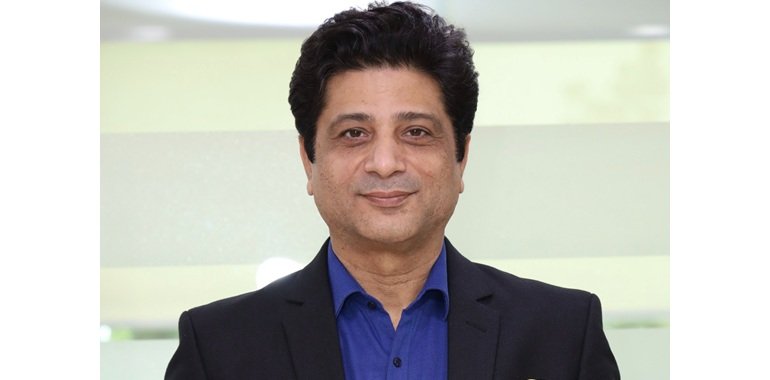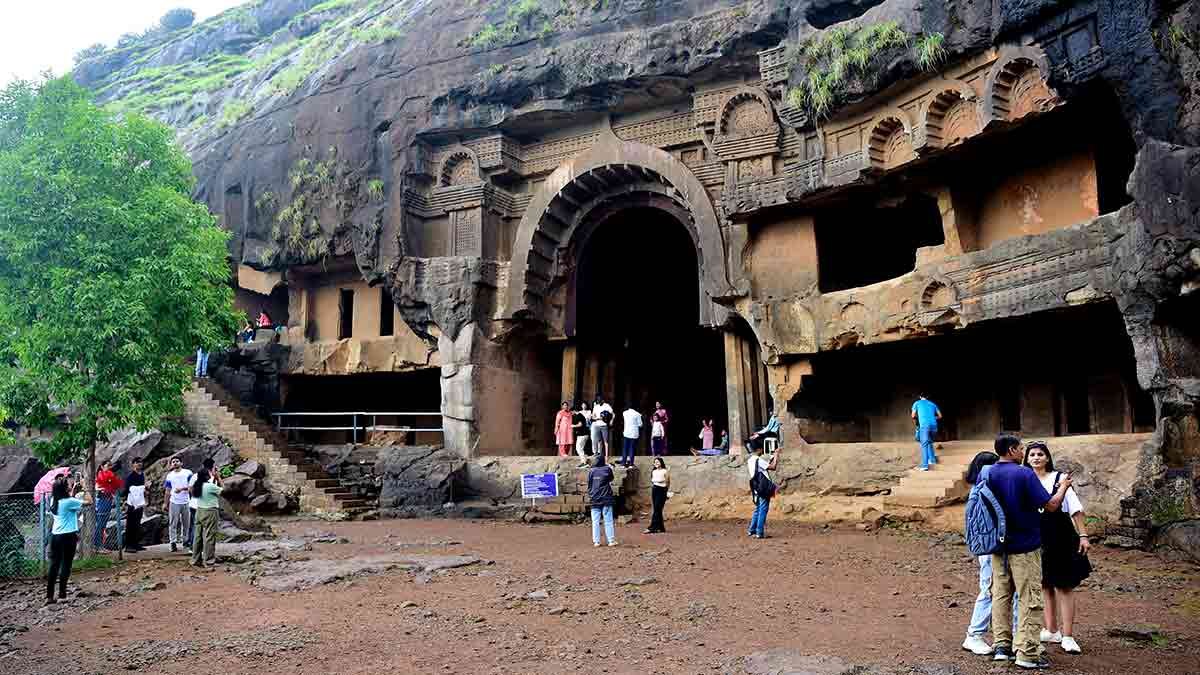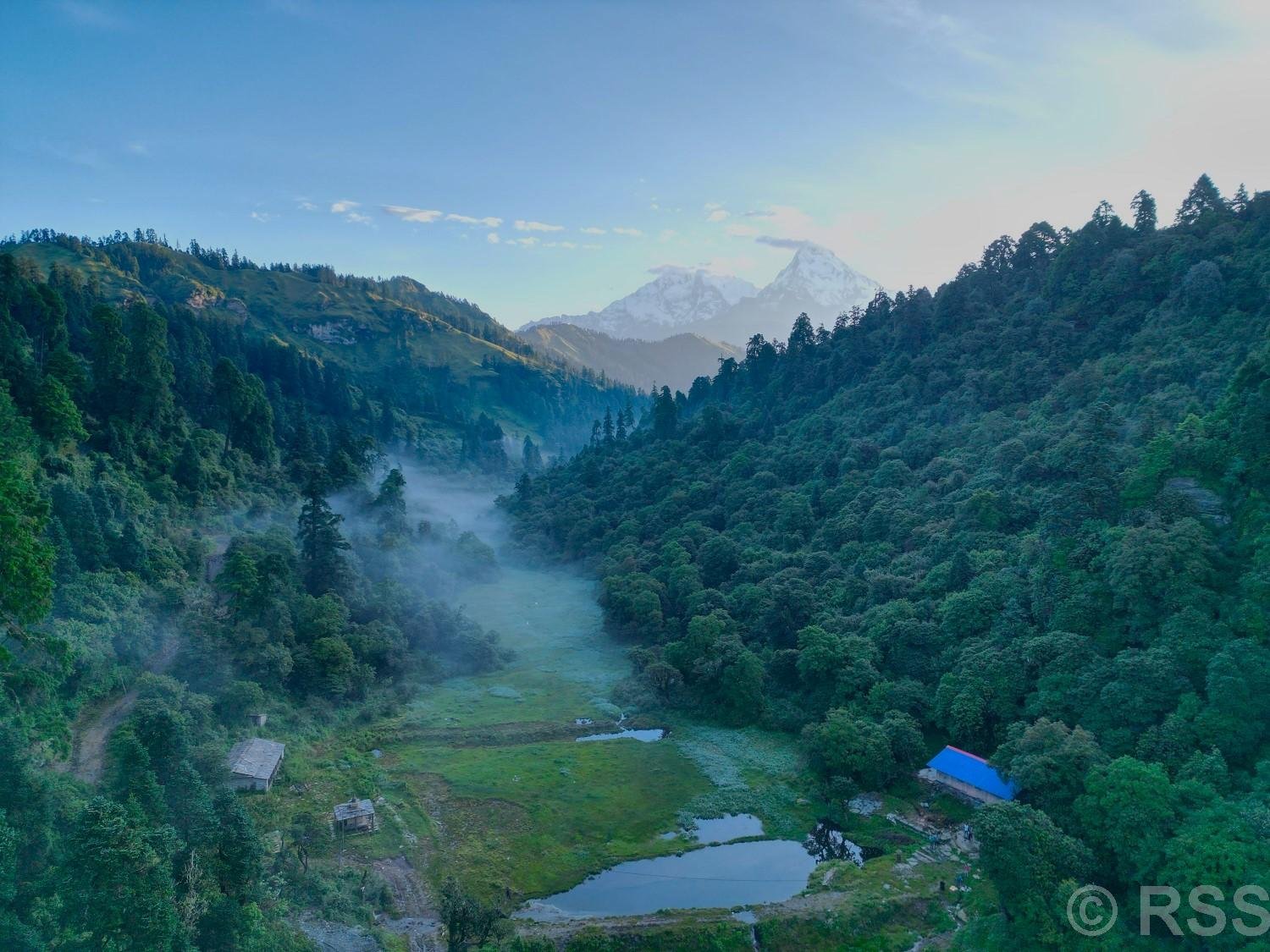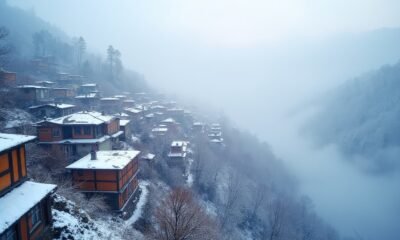Spiritual Travel
India’s Religious Sites turning into Real Estate Powerhouses

In the vibrant tapestry of Indian culture, where spirituality seamlessly intertwines with daily existence, an extraordinary economic phenomenon is unfolding. Religious destinations such as Salasar Balaji, Haridwar, and Ayodhya are transcending their sacred status to become catalysts for substantial economic transformation, particularly in the real estate sector.
This remarkable fusion of faith and commercial progress is not merely coincidental. Strategic infrastructure developments, particularly the expansion of expressway networks, have connected these once-remote spiritual havens to major urban centers, creating fertile ground for investment opportunities. The case of Salasar Balaji stands as a compelling example of this evolution, emerging as a prime destination for early-stage investors seeking significant returns on their capital.
The magnetic allure of these religious hubs is fundamentally reshaping India’s property landscape. Sites steeped in spiritual reverence for generations are now witnessing unprecedented demand for plotted developments. This surge attracts not only devout pilgrims but also astute investors recognizing the immense potential within these emerging markets. The harmonious blend of sanctity and improved accessibility has cultivated an environment where real estate ventures flourish, transforming quiet pilgrimage sites into bustling economic centers.
The recently introduced expressway connecting Gujarat’s Kandla to Panipat represents a pivotal development in this transformation. Passing through Salasar, this arterial route has dramatically enhanced connectivity, amplifying religious tourism and consequently generating substantial demand for accommodation, retail outlets, and residential projects. Salasar’s advantageous position near the Jaipur-Bikaner Highway, coupled with its accessibility from Delhi (a mere 3.5-hour journey via Jaipur International Airport), further solidifies its status as an attractive investment destination.
A deeper examination of market data reveals the impressive trajectory of plotted developments throughout India, with particularly robust growth in religious and suburban areas like Salasar. The Indian real estate market is projected to reach USD 332.85 billion by 2025, expanding at a compound annual growth rate of 24.25% through 2030. Plotted developments are significantly outperforming other segments, primarily due to their affordability and flexibility for potential buyers and investors.
Land price appreciation figures further underscore this trend. In metropolitan centers such as Gurugram, Hyderabad, Bengaluru, and Chennai, residential plot values have increased by 13-21% annually since 2018, substantially outpacing apartment price growth of just 2-6%. Emerging religious hubs like Salasar are experiencing similar patterns, with land prices doubling or even tripling in certain areas following the COVID-19 pandemic, driven by limited availability and escalating demand.
The pandemic has indeed played a significant role in accelerating this trend, fostering a pronounced preference for independent homes and consequently driving demand for plotted developments. A 2022 analysis by Housing.com indicated that land prices in suburban areas and Tier II/III cities, including religious centers, have doubled in various locations. Salasar has particularly benefited from this shift, leveraging both its spiritual significance and enhanced connectivity to attract investment.
Regional data provides additional perspective on this growth potential. In Hyderabad’s Manikonda, a comparable emerging market, residential plot prices increased by 3% in just 4-5 months during 2024, with projections suggesting 15-20% appreciation within a year. Given Salasar’s growing religious tourism sector and ongoing infrastructure improvements, even more substantial growth appears likely.
For early-stage investors, the Salasar Balaji area presents a rare opportunity to achieve extraordinary returns, potentially exceeding 100% within a relatively short 24 to 36-month timeframe. This projection is substantiated by compelling market evidence. In the Delhi NCR region, land prices in developing corridors appreciated by up to 100% in 2024 alone, primarily driven by infrastructure enhancements and ongoing urbanization. Salasar’s improved expressway connectivity and flourishing religious tourism mirror these growth drivers, with local real estate professionals reporting annual price increases of 15-30% in recent years.
The economic impact of religious tourism cannot be overstated. The growing number of pilgrims visiting Salasar Balaji Mandir, further increased by improved transportation infrastructure, continues to drive demand for lodging facilities and residential developments. Industry analysis from 2024 estimates that religious tourism corridors generate between $500 million and $1 billion annually, with Salasar’s enhanced accessibility allowing it to capture an increasing share of this substantial economic activity.
Comparative market analysis provides additional confidence in Salasar’s potential. In Ayodhya, another prominent spiritual center, real estate prices surged dramatically following the Ram Temple developments, with social media platforms highlighting it as India’s “hottest investment destination.” Salasar appears to be following a similar trajectory but currently offers lower entry costs, providing early investors a valuable opportunity to establish positions before prices reach their peak.
The real estate market in Salasar is demonstrating tangible expansion, with new hotels and residential plots being developed at an accelerated pace. This growth is directly linked to the area’s dual role as both a pilgrimage destination and an accessible weekend retreat. Unlike saturated urban markets, emerging areas like Salasar offer more attractive entry points with significant potential for appreciation as infrastructure continues to mature. Investors entering the market now can secure properties at competitive rates, with realistic expectations of doubling their investment as demand for both residential and commercial real estate intensifies over the next two to three years.
Beyond pure financial returns, the synergy between spirituality and commerce in Salasar is fostering innovative collaborations that contribute to sustainable community development. Investments in essential services such as healthcare facilities, improved sanitation, and micro-entrepreneurship ventures—ranging from accommodations to retail establishments—are creating a robust economic ecosystem that simultaneously enhances property values.
As Salasar evolves into a more vibrant urban center, significant attention is being devoted to safety and security considerations. Substantial investments in advanced security systems, efficient emergency response frameworks, and thoughtful urban planning are creating secure environments that bolster investor confidence in the long-term stability of the market.
The spiritual essence of Salasar provides additional economic benefits, driving demand for artisanal crafts and devotional products that fuel a vibrant local market. This cultural richness effectively blends traditional practices with modern enterprise, helping to ensure stable and sustained real estate demand.
The transformation of religious sites into economic hubs generates substantial employment opportunities through businesses such as hotels, restaurants, and retail establishments. This economic advancement empowers local communities, fostering financial independence and elevating living standards, which in turn supports a robust real estate market.
Strategic infrastructure improvements and sustainable urban planning initiatives are ensuring that Salasar’s development will be both progressive and enduring. Modern amenities coupled with environmentally conscious initiatives make the area increasingly attractive to high-net-worth investors seeking sustainable returns on their capital.
Active community involvement represents another crucial factor in Salasar’s development narrative. Support for small businesses and startup ventures ensures that economic benefits are distributed equitably. Community-driven projects foster a sense of ownership and pride among residents, contributing to market stability for investors.
While challenges inevitably accompany such rapid development—including land acquisition complexities and environmental considerations—these issues are being addressed through innovative public-private partnerships and sustainable practices that safeguard investor interests while ensuring seamless progress.
Looking toward the future, Salasar’s long-term outlook appears exceptionally promising. With sustained investment and thoughtful planning, the area is positioned to become an exemplar of spiritual and economic harmony, offering early investors the potential for exponential growth within a condensed timeframe.
The evolution of India’s religious sites into dynamic real estate hubs powerfully illustrates the transformative potential created when infrastructure development aligns with deeply held cultural values. Salasar Balaji, with its surging plotted development sector and impressive land price appreciation—evidenced by 15-30% annual increases and potential triple-digit returns—stands as a compelling opportunity in India’s evolving real estate landscape. For discerning early-stage investors, the coming 24 to 36 months present a window for extraordinary gains, supported by robust market data and unstoppable momentum. This vibrant confluence of tradition and progress heralds a future where sacred spaces thrive not only as centers of spiritual fulfillment but also as engines of economic prosperity.
Note: Dr. Ashish Kaul is a business re-engineer, Real Estate Advisor and Senior Fellow Ministry of Culture.
Spiritual Travel
Atul Patne, Maharashtra tourism principal secretary- The Week

Interview/ Atul Patne, Principal secretary, tourism, Maharashtra
Maharashtra’s tourism potential is vast—ranging from beaches and heritage sites to wildlife reserves. In an interview, the state’s Principal secretary, tourism, Atul Patne, explains what makes his state a unique travel destination. Excerpts from an interview:
What is your strategy to position your state as a year-round destination?
Maharashtra is already a year-round destination. From beaches, heritage sites, and wildlife reserves to mountains, food, festivals, spirituality and adventure, Maharashtra truly has something for every traveller, every time of the year.
Unlike many northern states, Maharashtra enjoys a moderate climate. The monsoon season sees a significant influx of domestic tourists. From October to March, we witness strong international footfall. Even during the peak summer months of April and May, our beaches and coastal destinations remain popular.
How do you plan to promote lesser-known destinations like Lonar and Amboli?
Destinations like Lonar and Amboli are already gaining popularity, particularly among young travellers and special interest groups such as nature clubs, bird-watchers, photographers, cyclists, bikers, and road trip enthusiasts—largely thanks to social media. A special tourism circuit is being developed connecting Nashik, Nagpur, Chhatrapati Sambhajinagar, and Lonar, supported by enhanced rail and road connectivity.
How is Maharashtra aligning its tourism development goals with sustainability and environmental protection, especially in ecologically sensitive areas?
This is a topic very close to my heart. We are promoting responsible and sustainable tourism through policies that encourage homestays, bed-and-breakfast accommodations, and small hospitality ventures—especially those led by women under the AAI scheme.
Do you have plans to revamp branding and marketing outreach?
We have significantly stepped up our marketing efforts, focusing on young, adventure-seeking audiences. Our campaigns showcase Maharashtra’s rich history, forts, coastline, Sahyadris, spiritual sites and vibrant cuisine. Innovative initiatives include inviting global food experts to promote our cuisine and organising a walkathon during the centuries-old Pandharpur Wari pilgrimage. For business tourism, we have established the Maharashtra Convention Bureau to attract MICE events.
What role does rural and agro-tourism play in your vision for inclusive tourism development?
It is central to our sustainable tourism policy. Through the AAI scheme, we are enabling villages to become tourism hubs. A successful model has already been implemented in Chinchani near Solapur. These initiatives generate local employment, preserve rural traditions, and reduce migration of young people to cities.
Could you talk about upcoming infrastructure projects that aim to boost tourism?
Our tourism policies include incentives for large-scale projects like aquariums, island development, and theme parks. We are actively encouraging public-private partnerships under the Viksit Maharashtra 2047 vision. NRIs are also being invited to invest in their ancestral towns to aid local development and tourism infrastructure.
Are there dedicated efforts to revive heritage tourism with guided storytelling, digital experiences, or festivals?
Forts are the pride of Maharashtra, and we are working closely with the ASI to take over select sites for development. Plans include experience centres, museums, immersive AI domes, and festivals that celebrate our forts, food and cultural heritage.
What are you doing to improve tourist experience, especially in popular but crowded spots like Lonavala or Shirdi?
We are focusing on behavioural change through clear signages, awareness campaigns and messaging to encourage responsible travel. Fines and regulations are being strengthened. At the same time, we are working on deploying a tourism security force and are conducting safety audits—especially for adventure operators. We want to bring about the change in the mindset of the crowd and that is a daunting task, but we will get there.
Ultimately, both tourists and authorities must share the responsibility to maintain these destinations. As for safety, we are setting SOPs for adventure tour operators, ensuring safety audits, deploying tourist police. These are some of the plans in the pipeline.
What is your vision for Maharashtra in the next five years?
Our goal is to make Maharashtra the number one tourism destination in India. We aim to do this through a model that is sustainable, inclusive, humanitarian and community-driven.
Spiritual Travel
Sobhita Dhulipala visits Velankanni Church and Nagore Dargah during spiritual trip to Tamil Nadu – Watch |

Actor Sobhita Dhulipala recently shared some pictures of her spiritual getaway in Tamil Nadu. The ‘Made in Heaven’ star took to Instagram on Thursday to share glimpses from her serene trip, which included visits to the iconic Velankanni Church and Nagore Dargah.
At Velankanni Church and Nagore Dargah
The actor shared photographs of her travels in her post with the title of “Life lately.” In these images, Sobhita was seen in a white outfit praying at the Velankanni Church, known formally as “The Basilica of Our Lady of Good Health”. The church is one of India’s most frequented Catholic shrines.Sobhita also visited the Nagore Dargah, a prominent Sufi shrine in Tamil Nadu located in the coastal town of Nagore. For this visit, she wore a black outfit, which complemented the modesty of the Dargah as well as fit with the overall spiritual tone of the site. The Dargah is the final resting place of the Sufi saint Nagore Syed Abdul Qadir Shahul Hamid.
Enjoying the beach
Sobhita also shared pictures of herself enjoying some peaceful moments at the beach as the waves washed over her feet. One photo shows her, with a calm expression on her face, relishing the sun and the joy of the moment. Another photo shows her feeling completely joyful alone. She also shared a photo looking beautiful in a gold saree from a friend’s wedding.On the work front, Sobhita was last seen in ‘Monkey Man’, Dev Patel’s directorial debut, which did not see a theatrical release in India. She also starred in ‘Love, Sitara’, but has remained quiet about her upcoming projects.Sobhita made headlines last year after she got married to Telugu star Nag Chaitanya after a long rumoured relationship.
Spiritual Travel
Jaljala holds potential for religious tourism but remains neglected « Khabarhub

Jaljala area in Myagdi/RSS
MYAGDI: Jaljala, located at the tri-junction of Myagdi, Parbat, and Kaski districts, holds significant religious and tourism potential but remains largely neglected due to lack of infrastructure and promotion.
The Jaljala area, spanning Modi Rural Municipality in Parbat and Annapurna Rural Municipality in Myagdi, is referred to in Hindu scriptures as Hampal, Kalanjar, and Mrigasthali. Despite its religious importance, the area suffers from underdevelopment and poor accessibility.
According to cultural and heritage expert Prof. Dr. Jagannath Regmi, Hindu scriptures including Agni, Garuda, Kurma, Baraha, Skanda, Shivamaha, Padma, Brihannaradiya, Linga, Matsya Puranas, the Mahabharata, and the Shrimad Bhagavatam mention Hampal and Kalanjar.
“Despite being praised in sacred texts, Kalanjar—highlighted by Muktakantha in mythological literature—remains underdeveloped due to lack of publicity, remoteness, limited road access, and the absence of documented materials beyond oral traditions and natural and cultural sources,” said Regmi.
He noted that some ancient temples, shelters, and caves in the area are now at risk of disappearing due to a lack of protection. Religious texts claim that sages once performed penance in the Jaljala region, using its herbs for medicine, gaining spiritual insights, and offering Pinda (ancestral offerings) to attain salvation.
Tika Pun of Lespar, Modi Rural Municipality-4, who operates a small restaurant in Jaljala, said that due to limited awareness of the site’s religious and scenic value, tourist and pilgrim numbers remain low.
“Visitors mainly arrive during Mahayagyas held in autumn and spring. Otherwise, the place remains deserted,” he added.
Situated at an altitude of 3,300 meters, Jaljala features a gorge surrounded by breathtaking views of the Annapurna range. Just two decades ago, locals from Jaljala and Modi Rural Municipality used to graze cattle here during the monsoon, a practice that has since vanished.
From Jaljala, a 10-minute walk to Wi-Fi Hill offers views of Annapurna, while a 30-minute hike to Mateko Lake reveals panoramic views of Dhaulagiri, Annapurna, and Machhapuchhre.
According to Govinda Sharma, a visitor from Kushma, the scenic beauty of the region and surrounding settlements makes the challenging journey worthwhile.
Jaljala is also rich in biodiversity. Medicinal herbs such as bojo, satuwa, chiraito, amilo, brahmi (bholatapre), pashanbhed, jethimadhu, padamchalnu, niramasi, jatamasi, timmur, and siltimmur are found here. Wildlife sightings include deer along the banks and birds like vultures, cuckoos, and owls.
The region is accessible by trekking routes from Ghodepani, Pun Hill, Mohare Danda, Nagi (in Myagdi), and Modi Rural Municipality in Parbat. A dirt road connects Jaljala to Lekphant and Shalija in Jaljala Rural Municipality, according to Vice-Chairman Deepak Acharya.
“A grand yagya was organized to highlight Jaljala’s religious significance, and electricity has now been extended to the area,” Acharya said. “The federal government has allocated Rs 30 million for tourism infrastructure development here.” The Beni–Lekphant road has also been blacktopped recently, and further road upgrades have been requested.
-

 Brand Stories3 weeks ago
Brand Stories3 weeks agoBloom Hotels: A Modern Vision of Hospitality Redefining Travel
-

 Brand Stories2 weeks ago
Brand Stories2 weeks agoCheQin.ai sets a new standard for hotel booking with its AI capabilities: empowering travellers to bargain, choose the best, and book with clarity.
-

 Destinations & Things To Do3 weeks ago
Destinations & Things To Do3 weeks agoUntouched Destinations: Stunning Hidden Gems You Must Visit
-

 Destinations & Things To Do2 weeks ago
Destinations & Things To Do2 weeks agoThis Hidden Beach in India Glows at Night-But Only in One Secret Season
-

 AI in Travel3 weeks ago
AI in Travel3 weeks agoAI Travel Revolution: Must-Have Guide to the Best Experience
-

 Brand Stories1 month ago
Brand Stories1 month agoVoice AI Startup ElevenLabs Plans to Add Hubs Around the World
-

 Brand Stories4 weeks ago
Brand Stories4 weeks agoHow Elon Musk’s rogue Grok chatbot became a cautionary AI tale
-

 Brand Stories2 weeks ago
Brand Stories2 weeks agoContactless Hospitality: Why Remote Management Technology Is Key to Seamless Guest Experiences
-

 Asia Travel Pulse1 month ago
Asia Travel Pulse1 month agoLooking For Adventure In Asia? Here Are 7 Epic Destinations You Need To Experience At Least Once – Zee News
-

 AI in Travel1 month ago
AI in Travel1 month ago‘Will AI take my job?’ A trip to a Beijing fortune-telling bar to see what lies ahead | China












